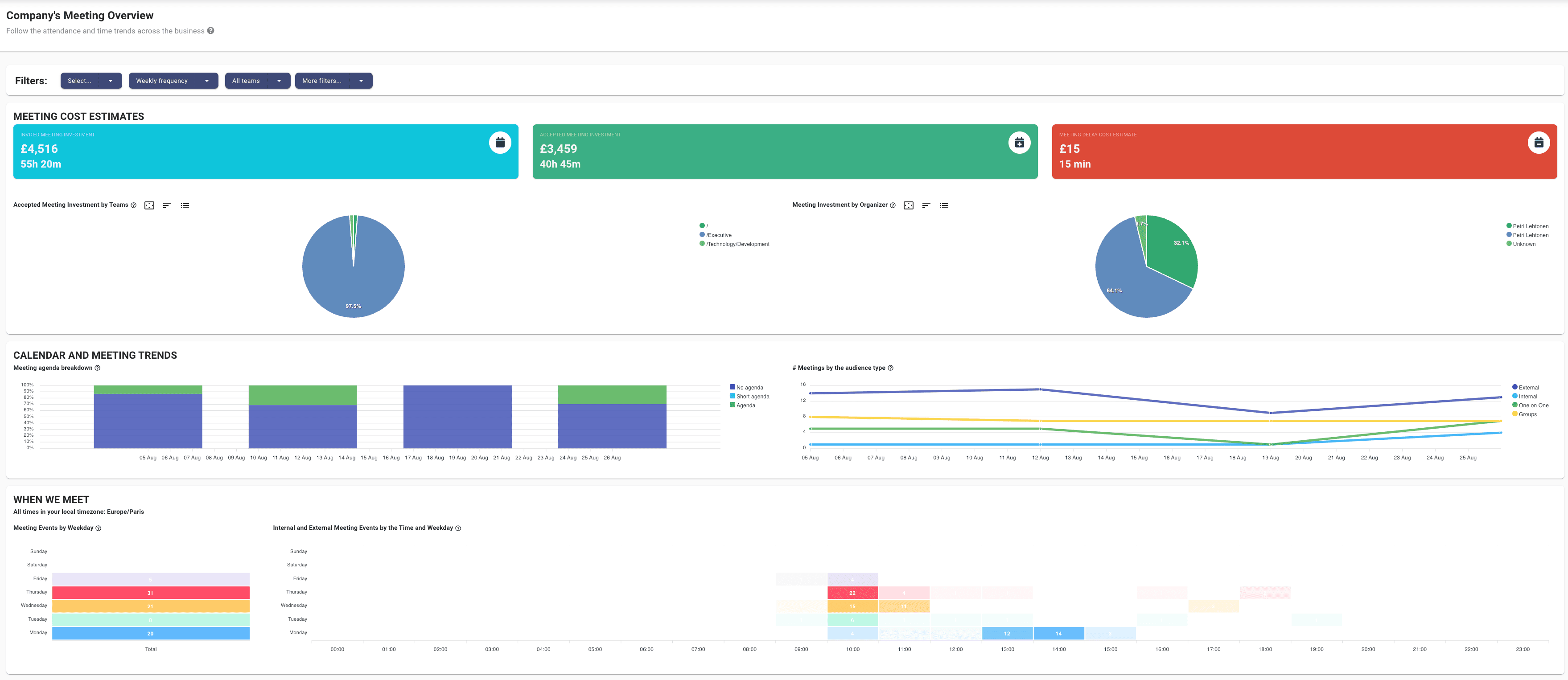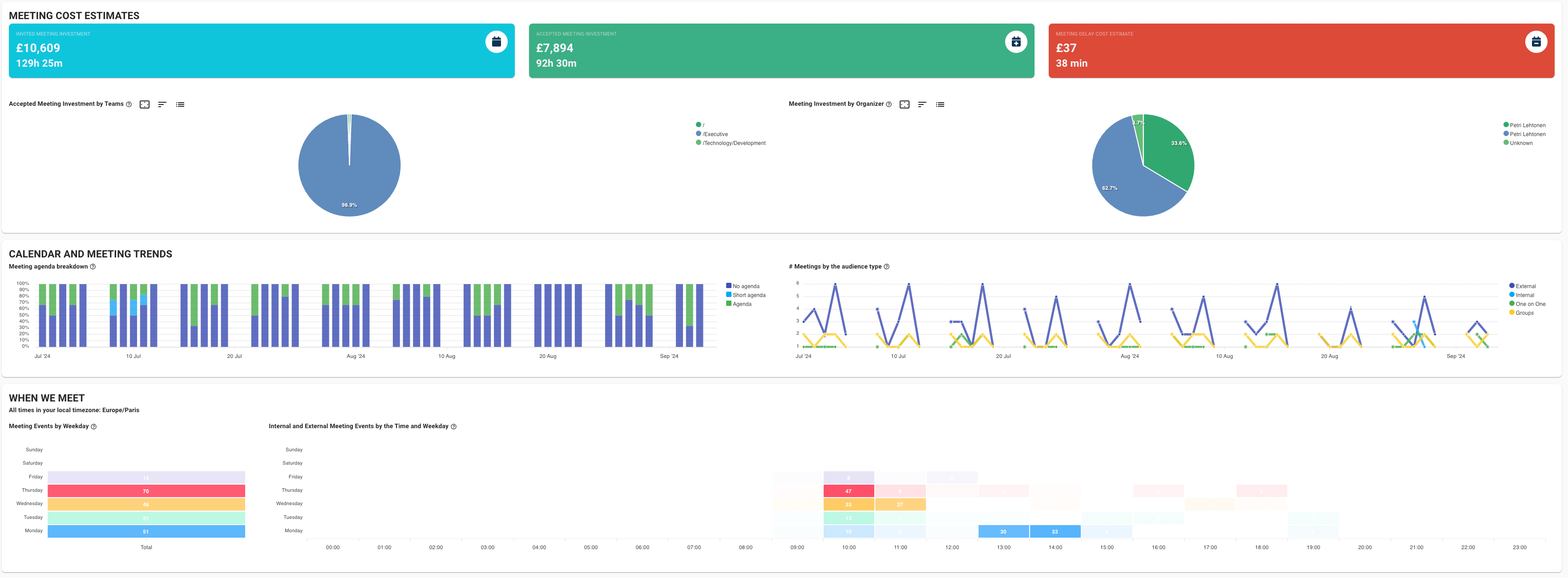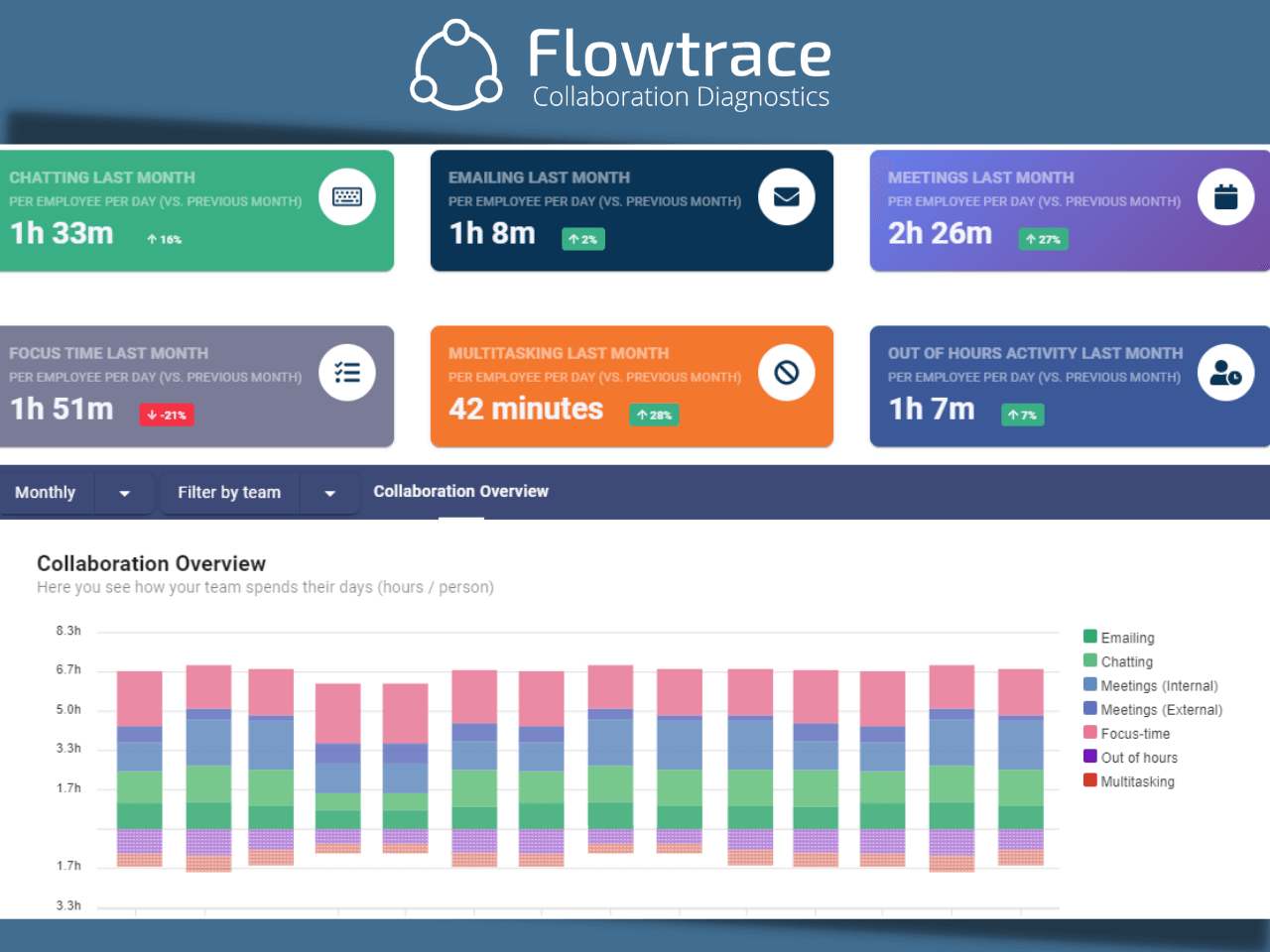It used to be simple, your calendar was just a personal tool to organize your day. But in today’s workplace, back-to-back meetings, constant context switching, and the erosion of focus time have turned calendars into a daily battle zone.
What looks like an individual problem, overbooked schedules, unclear priorities, and too many meetings, is often a reflection of deeper organizational inefficiencies. Your calendar isn't just a record of your time; it’s a mirror of how your company collaborates, communicates, and makes decisions.
Effective calendar management today means more than getting better at blocking time. It means understanding how your calendar fits into the larger system, how your meetings affect others, how company norms shape your day, and where wasted time accumulates across teams.
Personal productivity starts with the calendar. But true impact comes when individuals manage their time with visibility into the bigger picture. That’s when calendar management stops being reactive and starts becoming strategic.

The Modern Calendar Problem
Most professionals treat their calendar like a to-do list, but it’s actually a time budget. Every meeting, task, or time block represents a finite investment of attention, energy, and salary cost.
Common issues include:
- Double-booking and overlapping meetings, creating fragmented focus, and reducing decision quality
- No protected time for deep work, leaving people reactive instead of strategic
- Inviting too many people, which leads to overcrowded meetings and unclear accountability
These are more than bad habits, they’re symptoms of systemic problems. Calendars reflect your company’s culture and operating model. If no one has control over their time, the issue isn’t discipline, it’s design.
Using tools that provide calendar visibility and analytics allows individuals and teams to spot inefficiencies, balance workload, and plan more intentionally.
A recent study by Asana found that 58% of the workday is spent on “work about work”, including meetings, switching between tools, and status checks. Only 33% goes to skilled work itself. Calendars aren’t just personal planning tools anymore. They’re where time gets lost, or optimized, across your whole company.
Better Calendar Habits for Individuals
Improving calendar habits isn’t just about staying organized, it’s about defending your focus, reducing decision fatigue, and reclaiming control of your time.
Here are five simple but powerful changes you can make:
Time Blocking for Deep Work

Set aside dedicated blocks in your calendar for high-focus work. These blocks act as protected time, reducing distractions and increasing output. Companies that encourage deep work time often report better outcomes from fewer meetings.
According to a study, knowledge workers average only 2 hours and 48 minutes of productive time per day, with meetings and interruptions being the primary cause of lost focus.
Use Meeting Buffers and No-Meeting Zones
Add 5–10 minute buffers between meetings to allow decompression and preparation. Go further by enforcing no-meeting days or blocks of time during the week for uninterrupted work.
Set Default Meeting Durations
Avoid calendar defaults of 30 or 60 minutes. Try 25 or 50 instead. Small changes like this make meetings sharper and give people space to think. Calendar optimization strategies show how reduced durations can lower overload.
Review Recurring Invites Monthly
Recurring meetings often outlive their usefulness. Use a meeting audit to review and cancel or consolidate anything that no longer serves a clear purpose.
Use Agendas as Gatekeepers

No agenda? No meeting. Teams that enforce this see improved participation and reduced time-wasting. Agenda validation tools can help enforce this standard automatically.
When you start measuring and adjusting your calendar practices, you’ll realize how much control you actually have. And when that happens across a team or organization, the impact multiplies.
The Missing Piece: Feedback and Data
Most people never improve how they use their calendar, because they never see the patterns.
You can’t fix what you don’t track. Without visibility into where your time is actually going, it’s easy to drift into default behaviors: accepting every invite, sitting through hour-long calls that could’ve been emails, or sacrificing focus time to stay “available.”
That’s where data comes in, not just for leaders, but for individuals.
With tools that provide calendar dashboards and insights, you can track how much time you're spending in meetings, how often you get uninterrupted work time, and where recurring invites are bloating your schedule.

You can also identify patterns like:
- Spending more than 50% of your week in meetings
- Having little to no deep work time
- Being pulled into meetings with no agenda or clear purpose
- Attending meetings where your role isn’t clearly defined
On top of that, you gain access to key data on meeting cost and time investment, showing you the hidden toll your calendar takes, not just on you, but across your team.
And when these insights are aggregated across departments or roles, companies can use meeting analytics to uncover inefficiencies, optimize scheduling patterns, and align time use with strategic priorities.
Feedback loops aren’t just for products, they’re for calendars too. If you want to manage your time like a pro, you need data. Because until you measure it, you’re just guessing.
Where Tools Like Flowtrace Come In
Fixing calendar chaos doesn’t start with better habits, it starts with better visibility.
Modern calendar management tools go far beyond scheduling. They integrate directly with systems like Google and Outlook to surface the kind of insights most people never see. That’s where Flowtrace steps in.
Through seamless calendar integrations, Flowtrace pulls real-time data from your existing tools to give individuals and teams a clearer picture of how their time is being used.

At the individual level, personal dashboards show:
- Total meeting time by week or month
- Percentage of time spent in recurring meetings
- Deep work loss due to overlapping or poorly placed meetings
- Meeting costs based on attendee count and role levels
Flowtrace also utilizes intelligent AI to help prevent overload before it happens. That might mean a reminder to add an agenda, a flag when a meeting has too many attendees, or a prompt to reconsider a long-running recurring invite that hasn’t delivered value in weeks.
For organizations, this means calendar management scales beyond the individual. Teams become more intentional. Time becomes more visible. And calendars start working for people, instead of against them.
Why Calendar Management Needs a Company View
One person’s improvement matters, but if the system around them is broken, their calendar will be too.
You can build perfect habits, block out deep work, and decline non-essential meetings, but if your team floods your schedule with last-minute invites or recurring syncs with no agenda, you’re still losing the battle.
That’s why calendar management needs to scale from individual effort to organizational insight.
With analytics across departments, functions, and roles, companies can:
The key is visibility, not to micromanage, but to empower teams with data to optimize collaboratively.
When time becomes a shared resource that’s respected at every level, calendar management shifts from being a personal challenge to a strategic advantage.
Organizational Calendar Management in Action
Calendar management becomes most powerful when it informs decisions, not just at the individual level, but across leadership, HR, and operations. Here’s how organizations are putting this into practice:
Leadership reviews weekly meeting load by department

By using calendar analytics dashboards, executive teams can monitor how time is distributed across functions. Are certain departments overburdened with meetings? Are key decision-makers being pulled into too many low-impact calls?
This visibility allows leaders to rebalance workloads and protect time for strategy and innovation.
HR tracks deep work time as part of well-being metrics
HR teams increasingly recognize that excessive meetings contribute to burnout and reduced engagement. With Flowtrace, they can track deep work time metrics across teams and roles, turning calendar data into an early warning system for overload. It’s a way to support well-being with measurable signals, not just surveys.
Ops uses cost insights to cancel redundant syncs
Operations and team leads can use meeting cost indicators to spot recurring syncs that deliver little value but consume significant salary time. Armed with cost-per-meeting data, they can trim unnecessary meetings and reinvest that time into higher-value work.
When calendar data becomes part of your operational toolkit, it stops being just a scheduling layer, and starts becoming a driver of performance and culture.
Personal Control For Meeting Culture Empowerment
Calendar management isn’t just about better habits, it’s about better systems. When individuals take control of their time and organizations support that with the right data and visibility, the entire company benefits. It's not just about booking fewer meetings, it's about making time count.
Empower your team to manage time smarter, and give them the insight to make it stick. That’s where real productivity begins.
